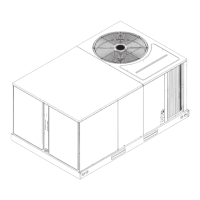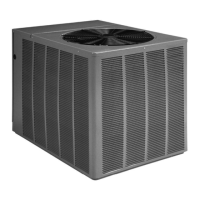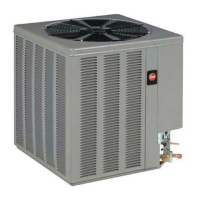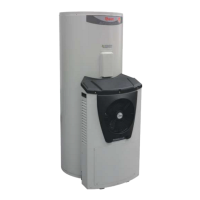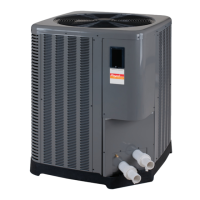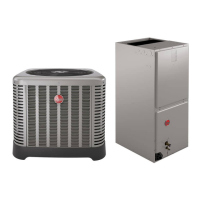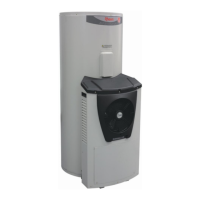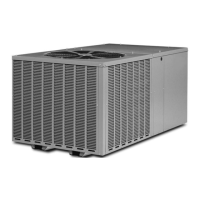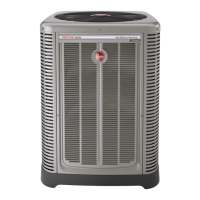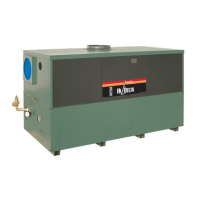42
10.0 DIAGNOSTICS AND TROUBLESHOOTING
10.6 General Troubleshooting Guide
Diagnostics
WARNING: Disconnect all power to unit
before servicing. Contactor may break only one side. Failure
to shut off power can cause electrical shock resulting in per-
sonal injury or death.
SYMPTOM POSSIBLE CAUSE REMEDY
Unit will not run
• Power off or loose electrical connection
• Thermostat out of calibration - set too high
• Defective control board
• Blown fuses/tripped breaker
• Transformer defective
• High-pressure control lock-out
• Low-pressure control lock-out
• Miswiring of communications (communication
light on continuously)
• Check for correct voltage at line voltage connections in con-
densing unit.
• Reset
• Check control board diagnostic codes
• Replace fuses/reset breaker
• Check wiring. Replace transformer
• Reset by cycling power to unit. Also see high head and low
suction pressure remedies.
• Check for refrigerant leaks.
• Check communication wiring.
Outdoor fan runs,
compressor doesn’t
• Run or start capacitor defective
• Contactor defective
• Loose connection
• Compressor stuck, grounded or open motor
winding, open internal overload.
• Low-voltage condition
• Replace
• Replace
• Check for the correct voltage at compressor. Check and tighten
all connections.
• Wait at least 3 hours for overload to reset. If still open, replace
the compressor.
• Add start kit components.
Insufcient cooling
• Improperly sized unit
• Improper indoor airow
• Incorrect refrigerant charge
• Air, noncondensibles, or moisture in system
• Bad ID EXV or TXV
• Recalculate load
• Check. Should be approximately 400 CFM per ton
• Charge per procedure attached to unit service panel
• Recover refrigerant. Evacuate and recharge. Add lter drier
• Replace EXV or TXV
Compressor short cycle
• Incorrect voltage
• Defective overload protector
• Refrigerant undercharge or undercharge (HPC
or LPC cycling)
• At compressor terminals, voltage must be 10% of nameplate
marking when unit is operating.
• Replace. Check for correct voltage
• Add refrigerant
Registers sweat
• Low indoor airow • Increase speed of blower or reduce restriction.
• Replace air lter.
High head, low suction
pressure
• Restriction in liquid line, expansion device, or
lter drier
• Bad EXV or TXV
• Remove or replace defective component.
• Verify thermistor and pressure transducer connection and
operation
• Replace EXV or TXV
High head, high or normal
suction pressure - Cooling
mode
• Dirty outdoor coil
• Refrigerant overcharge
• Outdoor fan not running
• Air or noncondensibles in system
• Clean coil
• Correct system charge
• Repair or replace
• Recover refrigerant. Evacuate and recharge
Low head, high suction
pressure
• EXV in bypass mode or TXV Check valve
stuck open
• Bad compressor
• Verify thermistor and pressure transducer connection and
operation
• Replace EXV or TXV
• Replace compressor
Low suction, cool com-
pressor, iced indoor coil
• Low indoor airow
• Operating below 65oF outdoors
• Moisture in system
• Restricted indoor coil circuit
• Increase speed of blower or reduce restriction. Replace air lter
• Add Low Ambient Kit
• Recover refrigerant. Evacuate and recharge. Add lter drier
• Repair or replace indoor coil
High suction pressure
• Excessive load
• Defective compressor
• Recheck load calculation
• Replace
Fluctuating head and
suction pressure
• EXV or TXV hunting
• Air or noncondensibles in system
• Check thermistor to suction line connection
• Check air distribution on coil
• Check suction thermistor and pressure transducer and opera-
tion
• Recover refrigerant. Evacuate and recharge.
• Remove and conrm EXV movement. Clean EXV inside with
nitrogen to remove any debris then reinstall
Gurgle or pulsing noise
at expansion device or
liquid line
• Air or noncondensibles in system
• Undercharged System
• Recover refrigerant. Evacuate and recharge
• Adjust charge per charging chart
